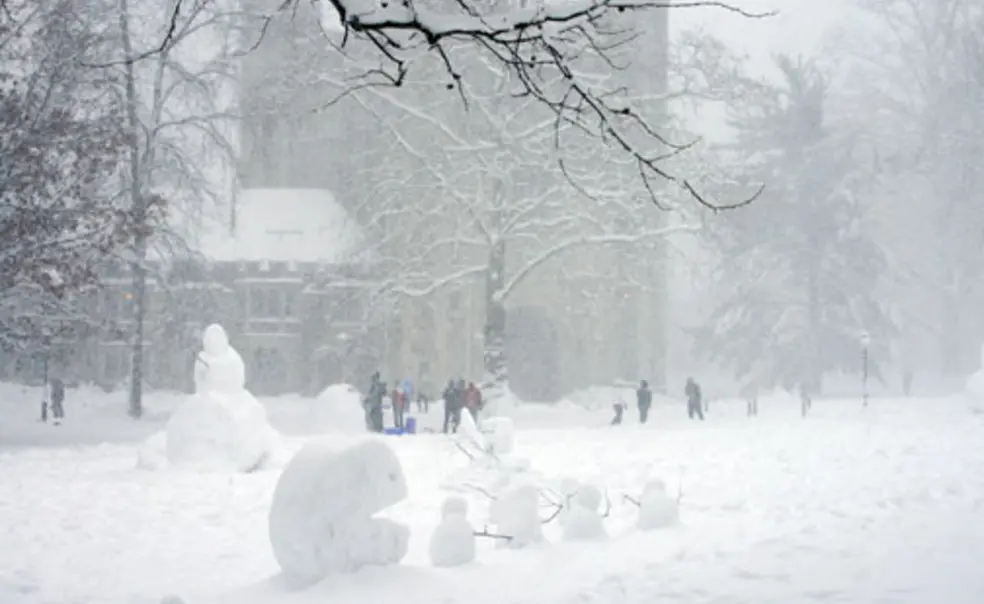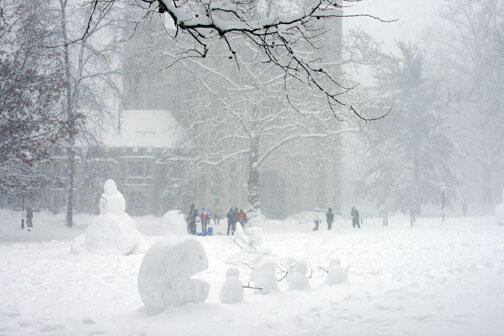Snow daze; talking sex
The Blizzard of Twenty-Ten, they’ll call it, The Day Princeton Stood Still.
Classes: canceled. Precepts: canceled. Libraries: heroically kept open.
But on Feb. 10, there was little time to study. Though snow days are rare here (the last was in 2003), students knew exactly what was expected of them.
There were snowball fights, of course, both spontaneous and scheduled (Field Hockey vs. Football at 3:30, College Republicans vs. Dems at 8). There was free hot chocolate from the USG. There was sledding down Whitman Hill, Princetonians gliding as far as their cafeteria trays would take them.
Most of all, there were snowmen — basic and elaborate, big and small, and most not even men at all. Instead, students let their imaginations run wild, turning the campus into a veritable zoo of frozen fauna.
Students built snow whales, snow squirrels, and snow turtles, even a snow stegosaurus. Unsurprisingly, snow tigers proved an especially popular subject.
Sophomore Stephany Xu surveyed the afternoon scene on Alexander Beach, where a giant snow Pac-Man stood poised to devour a string of panicked snow victims.
“Snow days mean childhood and playfulness and unicorns,” she said as she made her way through the foot-deep carpet on the ground. “Oh my God — I should make a snow unicorn!”
Across campus in Whitman courtyard, freshman Daniel Song conjured up a Renaissance-style sculpture of a woman and her baby, all soft curves and delicate beauty.
“I made a regular snowman first, but then I saw the mother and child in the snow and I had to make it,” Song said.
Nearby stood an igloo in the making, but the Housing Office took a dim view of such snow structures.
“For safety reasons, please refrain from building any snow enclosures on campus,” Housing wrote in a schoolwide e-mail. “Thank you for your cooperation and understanding.”
Freshman Christopher Teng worked on his own snow masterpiece.
“We attempt to derive meaning from snow ... but there is no meaning in snow. It’s a blankness,” Teng ruminated. “What are we gonna do with it?
“We make it in our own image,” he said while standing before his creation: a traditional three-ball snowman that lay decapitated, its head separated from its torso by simulated tire tracks.
By Isabel Pike ’11
“To talk about sex, you also need to talk about not having sex,” said Amelia Thomson-DeVeaux ’11, the co-founder of Let’s Talk Sex (LeTS), a student group that organizes weekly meetings to talk about, well, sex.
On a Tuesday night in February, Thomson-DeVeaux, wearing a strawberry-print dress and cowboy boots, welcomed about 50 students — mostly women — to “Perspectives on Abstinence” at Campus Club.
Emily Rutherford ’12 said she came to hear views from the middle of the spectrum of Princeton students, between the “abstinent Anscombe members and promiscuous members of the hookup culture.”
Like Rutherford, many Princeton students associate the word abstinence with the Anscombe Society, a student organization that has tried unsuccessfully to get Nassau Hall to support the creation of a campus Chastity Center.
One Anscombe member, David Pederson ’12, told the group that “for me, abstinence ends when marriage begins. But chastity is something that informs my whole life vision.”
The room was quiet as Stephanie “Q” Miceli ’12, who identifies herself as asexual, spoke. “For me, abstinence is not a decision. It is a fact of life.”
The noise level soared as students split into groups to discuss questions like whether abstinence is different for males and females and whether sex is a “make-or-break” part of a relationship.
Laura Hamm ’12 said the discussion was “surprisingly relaxed, given the politically and personally charged topic.” Students in her group “saw abstinence as a time to reflect on what sex should mean,” she said, “though some believed it was a strategy for success in marriage further down the road.”
Does abstinence play a large role on campus? According to spring 2009 data reported by the Undergraduate Student Government, 43 percent of students reported no sexual partners in the previous year.
“Princeton students have burning questions about flirting, sex, and relationships,” said Sophie Moskop ’13, a LeTS group moderator. “They want to talk about it a lot more than they admit.”
And Let’s Talk Sex wants to keep the discussion going. Next up is a speaker series on pornography.













No responses yet